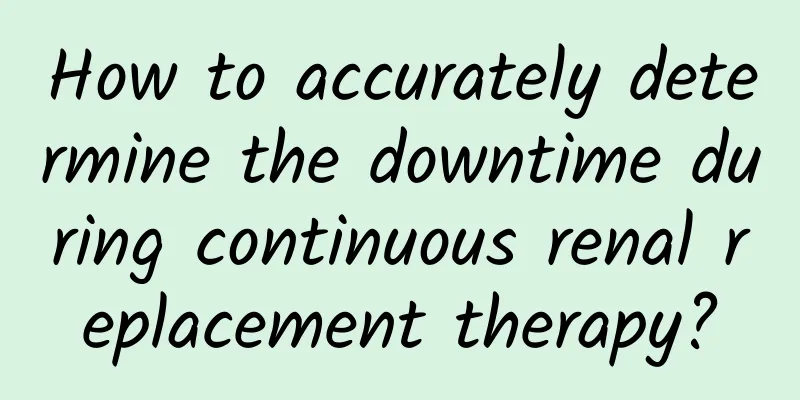How to accurately determine the downtime during continuous renal replacement therapy?

|
Acute kidney injury (AKI) is a common complication in critically ill patients, with high morbidity and mortality. Continuous renal replacement therapy (CRRT) is one of the important methods for treating AKI, and the timing of starting and stopping it is a problem often encountered by clinicians. This is because premature dialysis discontinuation may lead to inadequate dialysis, recurrence of the disease, and even affect the prognosis of the patient; excessive treatment will increase the patient's hospitalization time and hospitalization costs. Therefore, it is important for clinicians to master the CRRT discontinuation time for patients [1]. Why do patients with AKI need CRRT treatment? AKI is a clinical syndrome that refers to a sudden and persistent decline in renal function. Clinical manifestations include decreased urine volume, azotemia, water and electrolyte imbalance, metabolic acidosis, and systemic symptoms. It has a high mortality rate. Approximately 133 million people develop AKI each year, of which approximately 17 million die[2], seriously endangering the lives and health of patients. Therefore, once a patient is clinically found to have AKI, CRRT treatment should be performed as soon as possible to improve the patient's survival rate and prognosis recovery level. When do patients with AKI need CRRT? When AKI patients have the following 4 conditions, CRRT treatment can be considered. (1) Low urine volume and edema. The amount of urine directly affects the volume and cardiac function of AKI patients. Type III cardiorenal syndrome is a common clinical indication for pulmonary edema due to oliguria caused by AKI. (2) Hyperkalemia: When the serum potassium is >6.0 mEq/L, or >5.5 mEq/L and accompanied by active tissue decomposition such as rhabdomyolysis, crush injury, tumor lysis syndrome, or active potassium absorption such as severe gastrointestinal bleeding. (3) Severe metabolic acidosis . When acidosis is difficult to correct with medication or cannot be continued safely due to excessive volume load, consider using the machine. (4) The volume load is large and difficult to correct even after active diuresis. However, these treatment factors are not completely applicable. The specific CRRT plan and treatment timing still need to be combined with the patient's actual clinical situation to decide whether to use the machine. Which indicators indicate that AKI patients can stop ventilating? (1) Urine volume. The patient can be discontinued if the spontaneous urine volume is >500 ml/24 h, if the patient is not taking diuretics and the spontaneous urine volume is >1000 ml/24 h, or if the patient is taking diuretics and the urine volume is >2000 ml/24 h. If the urine volume is sufficient to cause a spontaneous decrease in serum creatinine concentration, then there is a mandatory indication for discontinuation of the machine. (2) Serum creatinine. Serum creatinine is one of the indicators for diagnosing AKI and an important indicator for grading the severity of AKI. It is closely related to the prognosis of AKI patients. If an increase in urine volume, an increase in the initial sepsis-related organ failure evaluation score, or an increase in serum creatinine is found during CRRT treatment, the CRRT can be stopped. (3) Urine creatinine. Studies have found that 24-hour urine creatinine ≥5.2 mmol is associated with successful weaning in 84% of patients, and diuretics have no effect on 24-hour urine creatinine. (4) Glomerular filtration rate (GFR). Assessment of GFR is crucial for evaluating renal function, drug dosage, testing, and estimating the prognosis of chronic kidney disease. The most common method for assessing GFR is to assess creatinine clearance through 24-hour urine collection. The GFR estimated based on the creatinine formula is expected to reflect the true GFR. (5) Creatinine clearance. Studies have shown that a 2-hour creatinine clearance of 23 ml/min has a sensitivity, specificity, and positive predictive value of 75.5%, 84.4%, and 88.8% for successful withdrawal of CRRT, respectively. Therefore, creatinine clearance can be used as an indicator for stopping CRRT. (6) Urea. When the daily 24-hour urea excretion level is >1.35 mmol/kg and the urea concentration is ≥148 mmol/L, the possibility of being able to leave dialysis increases significantly. In addition, some biomarkers such as cystatin C, kidney injury molecule-1, neutrophil gelatinase-associated lipocalin and liver fatty acid binding protein are more sensitive and specific than traditional clinical indicators. They usually increase before the blood creatinine increases, and can help determine whether to stop the machine to a certain extent. In short, CRRT suspension must meet two points: the patient's internal environment disorder is effectively controlled and the primary disease and complications are improved , and on this basis, combined with the patient's specific situation, it is judged whether suspension is necessary. References [1] Gaudry S, Hajage D, Schortgen F, et al. Strategies for initiating renal replacement therapy in the intensive care unit. Journal of Engineering Medicine, 2016, 375(2): 122-133. [2] Lewington AJ, Cerdá J, Mehta RL. Raising awareness of acute kidney injury: a global perspective of a silent killer. Kidney Int, 2013, 84(3): 457-467. [3]Xue Jinhong, Chen Lei, Wei Meng, et al. When to stop renal replacement therapy in patients with acute kidney injury[J]. West China Medical Journal, 2022, 37(07): 974-978. |
<<: Silver Age Health | Safety Management for Frail Elderly People
>>: What? The voice also ages?
Recommend
Can cervical erosion be detected by B-ultrasound?
Cervicitis is a common gynecological inflammation...
Is edema normal during 4 months of pregnancy?
Pregnant women should pay attention to changes in...
What is the level of serum human chorionic gonadotropin during pregnancy?
In life, some women have irregular menstruation a...
What medicine should I use for oral ulcers during lactation?
Getting angry during breastfeeding is a very anno...
What happens when there is a lump of flesh at the vaginal opening?
A lump of flesh appears at the vaginal opening. T...
Bleeding after taking birth control pills for half a month
Women must learn to protect themselves, especiall...
Man dies of sudden cardiac death after taking painkillers, revealing heart health crisis
Recently, a news report about a man who died sudd...
How to get up after cesarean section
After a cesarean section, you should pay attentio...
There is a big mole on the left side of the woman's back
Moles are very common to us. For many people who ...
How long will postpartum hair loss last?
Postpartum hair loss will take half a year, which...
How to improve female endocrine disorders
Women are very prone to endocrine imbalance. Long...
How to identify uterine prolapse and how to treat it
Total prolapse is a very harmful disease for wome...
What is the difference between the new and old Dior Forever Locking Air Cushion? Dior 2019 Locking Air Cushion New and Old Comparison Review
What are the changes of the new Dior Forever Lock...
Counterpoint: China's smartphone shipments fell 1% in 2017 compared to last year
The latest research data from Counterpoint Resear...
Why do women's nipples and areolas itch?
The breast is an important part of the female rep...









